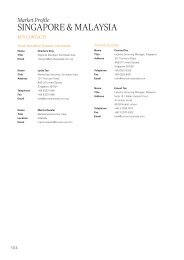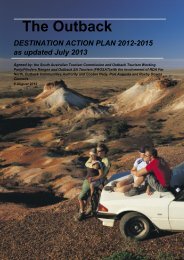Flinders Ranges and Outback Integrated Strategic Tourism Plan
Flinders Ranges and Outback Integrated Strategic Tourism Plan
Flinders Ranges and Outback Integrated Strategic Tourism Plan
Create successful ePaper yourself
Turn your PDF publications into a flip-book with our unique Google optimized e-Paper software.
Final <strong>Plan</strong><br />
Executive Summary<br />
EXECUTIVE SUMMARY<br />
Premise for the <strong>Plan</strong><br />
The primary purpose of this plan is twofold. Firstly, to increase the level of<br />
expenditure by those already visiting the region by providing additional <strong>and</strong><br />
enhanced products <strong>and</strong> services they will be willing to pay more for. Secondly,<br />
to increase the number of visitors to the region by addressing current gaps in<br />
transport, products <strong>and</strong> service <strong>and</strong> targeting marketing initiatives to those<br />
markets most likely to find that the <strong>Flinders</strong> <strong>Ranges</strong> <strong>and</strong> <strong>Outback</strong> SA offers what<br />
they are looking for.<br />
Underpinning the achievement of our primary purpose is the need to protect<br />
<strong>and</strong> enhance the natural environment <strong>and</strong> l<strong>and</strong>scapes that provide the source<br />
of the region’s appeal to visitors. It is also critical to ensure that rural<br />
communities are adequately resourced <strong>and</strong> supported to manage the<br />
impacts of tourism <strong>and</strong> provide satisfying experiences for visitors.<br />
The plan is built on the following six foundational premises:<br />
• Be true to who you are<br />
• Attract those who respect <strong>and</strong> value what you have to offer<br />
• Build on <strong>and</strong> strengthen existing quality products to generate immediate<br />
additional returns from current visitors<br />
• Focus on new developments – products <strong>and</strong> infrastructure – that reflect the<br />
essential character of the region <strong>and</strong> can be managed sustainably to<br />
deliver experiences your markets will pay for<br />
• Support the regional leaders in tourism to maintain their efforts to build the<br />
profile <strong>and</strong> position of the region<br />
• Align the rules to reinforce your vision for tourism.<br />
<strong>Tourism</strong> – A Vital Part of the Regional Economy<br />
In 2006 total tourism expenditure in the region exceeded $250 million <strong>and</strong><br />
contributed to 1,380 jobs, $145 million of gross regional product <strong>and</strong> an<br />
additional resident population of over 3,300 people. Unlike industries like mining,<br />
those who work in tourism are likely to live in the region with their families. Jobs<br />
in tourism generate a significant level of flow-on economic activity in sectors<br />
such as health <strong>and</strong> education.<br />
<strong>Tourism</strong> – The Key to Viable Communities<br />
For some small communities <strong>and</strong> pastoral properties, involvement in tourism<br />
offers them the best opportunity for long term viability. <strong>Tourism</strong> can keep<br />
people in communities, where other forms of employment take them out of the<br />
community. <strong>Tourism</strong> therefore provides obvious benefits for the sustainability of<br />
these communities, notwithst<strong>and</strong>ing the pressures it can place on these<br />
communities to manage <strong>and</strong> maintain the infrastructure that supports tourism.<br />
Urban & Regional <strong>Plan</strong>ning Solutions<br />
d:\frosa region istp\frosa region istp.doc





